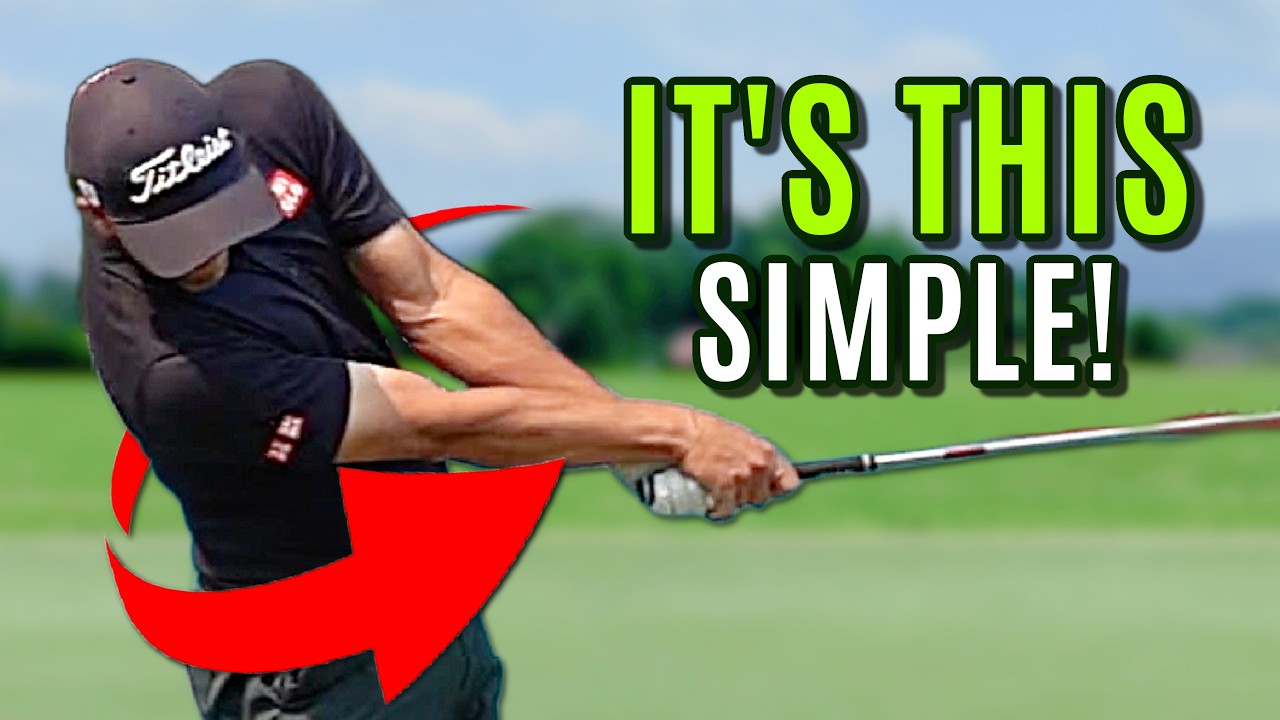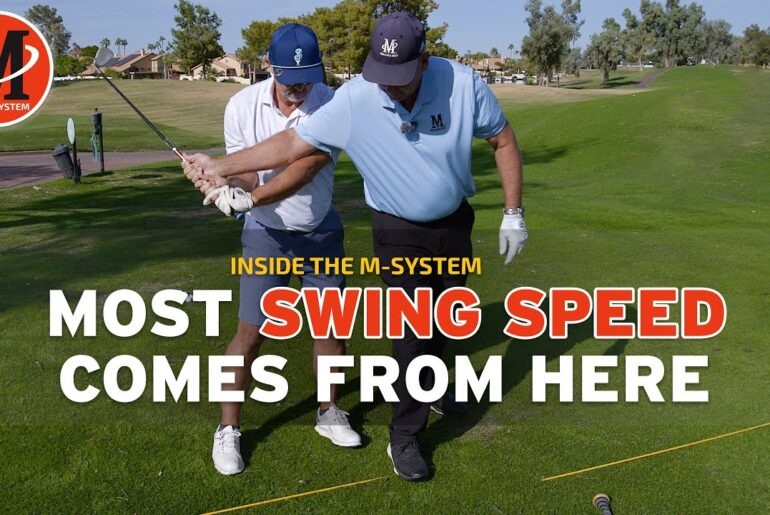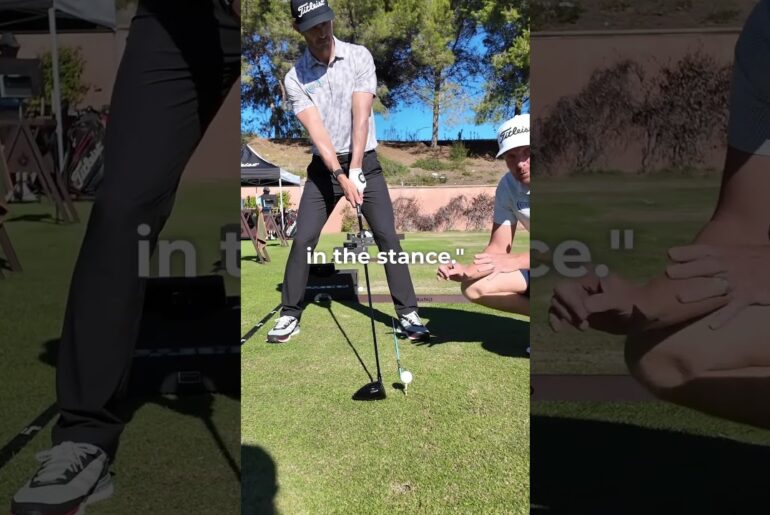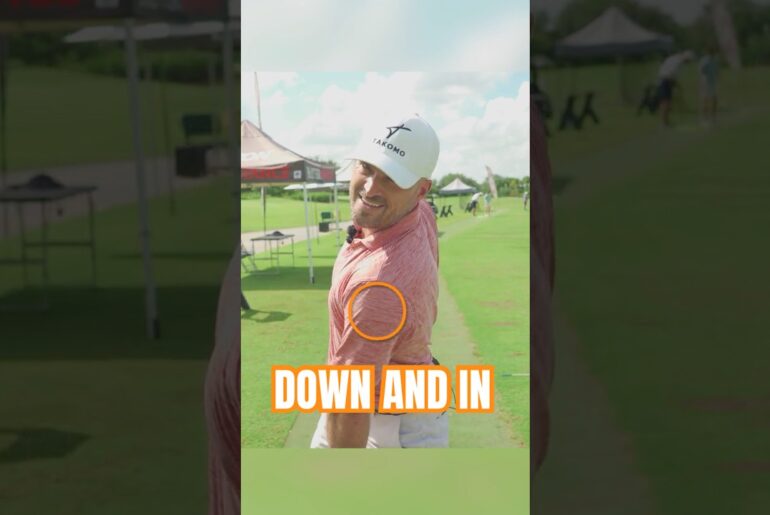VKTRY Insoles have had a huge impact on how I feel both on the lesson tee and the course! Use this link to get a 20% discount https://rstr.co/vktrygear/eric
How do PGA Tour players use their lower bodies in the golf swing?
How should I start the downswing?
How can I improve my impact position in my golf swing?
How do I keep my head back or still in my golf swing?
How can I get more extension in my golf swing?
In this video, Eric Cogorno and Craig Hanson answer all those questions, teaching how to start the downswing with proper lower body golf swing mechanics! They also reveal Craig Hanson’s Wall Drill to create separation in the golf swing for better impact position and solid contact.
⏱️ 0:00 – Craig Hanson’s Wall Drill for creating separation in the golf swing
🔍 2:09 – PGA Tour data: 4-6 inches of lower body golf swing movement
💪 4:13 – Wall drill setup and proper positioning technique
⚙️ 6:18 – Knee-to-ball timing to start the downswing correctly
🎯 8:46 – Craig Hanson’s Right Hand/Right Knee drill for closing the gap
✅ 9:13 – Left hip golf extension and shoulder positioning
🏆 12:18 – On-the-course course club drill for maintaining proper movement
🔧 13:36 – Final positioning checks and feel exercises
This lesson reveals how PGA Tour players use their lower bodies in the golf swing, moving their hips 4-6 inches laterally while keeping their head still. Master three proven drills that teach you how to start the downswing with your lower body while to achieve the perfect impact position.
What You’ll Learn:
• The wall drill for creating separation in the golf swing
• How PGA Tour pros move their lower body in the golf swing (4-6 inches)
• Proper technique to start the downswing with lower body first
• Left hip extension that helps prevents forward head movement
• Correct head in the golf swing positioning throughout impact
• Three drills for achieving the perfect impact position
• Extension golf swing mechanics for solid contact
• Right knee movement to close the gap between knees
• On-course practice methods for consistent ball striking
• Evidence-based coaching techniques from PGA Tour player data
#separationinthegolfswing #impactposition #lowerbodygolfswing #startthedownswing #lefthipgolf #headinthegolfswing #extensiongolfswing
All right, guys. Back outside here with Mr. Craig Hansen. Craig, today’s video is all about the wall drill. The wall drill. We know from the amateurs that we coach compared to the professional players, there’s a pretty big significance, pretty big difference, significant difference in how they start the down swing and what they do through the golf ball. And I know a lot of the things that you do, evidence-based coaching, worldclassgolf.com, some of the measurements on what the best players do on the way down, how they get through the wall. I’d like to talk about that specifically, how much they move forward, what we’re trying to do, lower body versus upper body, and then there’s a couple cool simple drills that you do that I’m going to ask you about that we’ll go through. But let’s kind of start with giving some information. What are the pros doing on the way down? Yeah. Creating this separation in the swing. So, what we’re seeing like the PGA average, the average on tour, what we’re seeing is from the address position moving down through the ball, we’re seeing four to six inches of lateral shift here with the lead hip. So that’s 10 to 15 cmters. That’s the average. You will see players with heaps more, right? So if you’re looking at a Colin Mari Cow or Sheffller or uh Fleetwood, these players, they will shift a lot more than that, but that’s the that’s the average on the PGA Tour. Okay. Four to six inches. Yeah. And what we’re seeing then with the head position with the irons is it’s pretty much not moving at all. You might see 1 cm forwards with some of the iron shots, but generally speaking, this is what you’re seeing, the separation from the top half to the bottom half. And unfortunately ams are just not getting close to that. And we’ll put some players on the screen guys when you’re watching to kind of show some of the visuals Craig’s talking about. Craig, let’s take your setup position for me. So when we say 4 to 6 in, are you measuring that from where you start? Let’s take your setup again. Yeah, it’s measuring it from from where you start. Yeah. And this is how this is then how we we can shift across and then get ourselves through through the wall where every great player is. I mean, this is like a checkpoint. This is like if you are filming your swing, if you do want to improve your golf, I mean, you just have to look at this this area. It’s just evidence-based. This is where they are. And the closer you get to it, the better you’re going to hit the ball. I I love when you say that, Craig. It’s such a beautiful line with all these things. The closer you get, the better you’re going to hit it. So, if you take your setup one more time, so if you guys draw a line kind of from where Craig’s hip is, or we can put on the screen, and we were to put an imaginary line forward that’s about 4 to 6 in, we’re saying that’s what we’re trying to get to during the down swing. Right. That’s it. And is this Craig, when you do this, do you put the line, is it kind of like right outside the foot? No, it’s right on the side of the ankle. That’s a good question actually. It’s right on the side of the ankle. And sometimes like we got shorts on today cuz I didn’t know it got that hot in this area of the world. But we got when we got the pants on, I just do it from the pant line straight up. And at times you’ll have a little bit of the shoulder through the wall. You pretty much want to be standing I mean up against the wall for the masses of the people out there. We’re not saying stack up the weight on the left, but with your iron shots, I mean, if you see someone like an Adam Scott who’s standing back over this way and has just one of the biggest lateral shifts through the golf ball, okay, he’s probably going to stand a little bit wider and not up against the wall. But for all the people out there that really want to create better shaft lane, compression, and consistency of strike, you really want to have a little bit more weight favoring the lead leg. And that gets us closer to be able to shift and move through the ball, which is just huge. So, we kind of have an idea here of like, okay, great. That’s what we’re looking to do, right? I want to ask a couple more details, and then we’ll talk through some of the drills and feels. I’ll hop in kind of as a student do them. Um, in terms of the down swing, and when you communicate this, you say the goal is to move that left hip. And really, let’s say the lower body. Yeah. Four to six inches forward. But while you’re doing that, the head or upper body is supposed to stay back over the golf ball. And as the hips are moving forward, those four to six, right? The head staying back over the golf ball line. And the hips, Craig, aren’t moving just forward. Correct. They’re also turning. Of course, there’s going to be obviously, I mean, to get the appropriate amount of of turn in the swing, that’s also important. by just it’s going to be shifting at the start, but it’ll be gradually turning at the same time. And there’s a there’s a really good checkpoint here for us, Eric, in and around impact for for a lot of people. So, what we’re looking at doing if you can get if you have a finish line here directly over the golf ball and you’re getting into impact, you really want to be able to get your your knee to the finish line before your hands do. And this is sort of setting up an awesome sequence. And once you have the knee shifting, you’re also going to be creating that rotation and that shift. And then we get inside a zone where it’s really nice stuff. Let’s flip-flop spots, Craig. I like that. Let me start with that first. So, one of the ways for someone to start to feel like they’re moving forward is we’re trying to get the knee to the ball before the hands get there. Exactly. That that sets off a wonderful chain reaction. Knee to the ball. So, it’s kind of It’s hard to get my knee working forward without my hips going forward. Yeah. Is that kind of the point of it? Yeah. Exactly. Like, if I’m getting my knee going, I’m going to have some movement. Let me do that once or twice here. So, knee to the ball before the hands. Knee to the ball before the hands. That’s it right there. Okay. Let me Let me try that here. Knee to the ball. And that’s not saying knee to the ball this way. Oh, no. The right knee moving in towards the left, closing up the gap of your knees. It’s such an important area. So, it’s knee to the ball in terms of where it is forward or back. But the knee is working towards the left knee. And the kneecap we actually want to get the point like towards the target. Yeah. It’s a feeling of the right leg moving moving inwards. When we draw a line up this right leg here for amateur players, unfortunately they’re leaving the right knee out over the right ankle and this is just causing all sorts of different issues. They’re staying back here with the knee. Yeah. And the better players are going forward with the knee. That’s it. That’s okay. I like that. So knee forward to the ball before the hands kind of closing the gap from the right knee to the left. Yeah. uh and hit it like that. I mean that’s that for me that I mean that’s very very solid. So right knee in towards left. So I feel like when I’m doing that and you guys can be feeling these similar things. So guys I’m doing this kind of what I’m feeling here that right knee’s getting in towards left. I like that a lot Craig. So I’m sort of I’m I’m making the gap go away. I’m getting the kneecap towards the target. Yeah. And that’s a really good visual to be getting the knee forward of the ball. Let me try that one more time. Right knee forward of the ball. Yeah, that’s another one. Yeah, that feels really good. Yeah, that’s pure. Imagine finishing your rounds with the same power and precision you started with. Leg fatigue affects your swing mechanics and power. That’s where Victory Insoles make all the difference. Victory Insoles with revolutionary carbon fiber technology now gives you the stable foundation your golf swing demands. Victory’s spring-like design improves energy conservation from back swing to follow through, increasing your club head speed and distance without changing your technique. Get the solid base you need with Victory. Whether you want to add yards to your drive or just outdrive your buddies, Victory gives you the edge. Use my link in the description for a 20% discount. It’s so difficult for a lot of players out there to create this separation. And even for players at times bringing the right knee in, they’ll tend to bring the the shoulders in a little bit too level. And look, it’s a diff difficult area. It’s just one of those separation points in the swing. If you haven’t played junior golf or heaps of it, and look, it’s not that easy. But this is this is a great drill here to not only create separation, but also to find that that impact position or moving through the ball effectively here. Now, what we’re going to do is you take your address. Imagine you’re standing in your address position. Get your hands on the outside of your thighs and you’re going right hand, right knee, left hand, left hip. Now, you’re closing up the gap of your knees. Now, what this is doing is if my left hand works up my left hip, it’s creating extension. And what that’s doing is it’s acting, it’s almost getting the shoulder to act as a wall. If your lead shoulder is up high, you won’t move your head forwards, right? If your lead shoulder moves level, you’re going to bring your head forwards. And this is where amateurs around like this. I know it sounds funny, but it’s affecting millions of golfers here. So have a look at this. Right hand, right knee. And if you’re on the couch, jump up and give it a go. It’s actually good fun to do, right? Right hand, right knee, left hand, left hip. Closing up the gap of the knees, right? And you can get a feeling of that. And then just make some movements. And all of a sudden, we start to get extension as we’re moving forwards. And that’s the difficult thing with the golf swing. There’s things moving and twisting in different directions, isn’t it? So we’re moving forward. The unnatural thing is probably to lift this shoulder. And the more natural thing is like the bus driver swerving down the road and moving in this direction. Everything going forward. God, I like that as a next little logical add-on. Let me try that. And I’m gonna hit with that. So, okay, I’m still keeping the right knee forward piece. You said like that’s could be my starter point. Right knee forward. So, if I just go hands here, right hand, you get your hands up a little higher. So, they’re up up a little bit higher. Okay. And then slide the right hand down to the left knee and then up forwards. Then you’re closing up the gap of the knees there. So, as the left hand works up the hip, this is this is when we start to get extension. This is where your chest will actually start to point up through the golf ball. This is where we’re this is a good place. This is the good stuff, Eric. Right. This is how you move through a golf ball by creating the tilts and the turns that we need. And that keeps my upper body back. Yeah, definitely. Okay. So, my left side’s getting higher, my right side’s getting lower as my right knee goes forward. Now, as you guys are doing this, one of the things that Craig says that’s so good is the closer you get, the better you hit. Okay? So, the closer you get, the better you hit. Meaning, you don’t have to do this perfect. Hey, I can’t move that well. That’s okay. But the closer you get, the better you hit. The closer you get, the better you hit. So, you’re just trying to move in these direction. I think that’s a really, really key point. So, as I’m as I’m doing that, Craig, I’m So, I’m trying to feel what I felt there as I’m doing the knee forward really was like a right side crunch. Yeah. Yeah. I feel like my head staying, you know, I feel like my head’s staying back as my lower body’s pushing forward, but I feel the right knee moving forward with a little right side crunching. Let me go ahead and hit with that same sensation. Yeah, that was really solid as well. I really like that right knee. the right knee instead of going this way and nowhere is closing the gap that way. Moving it in this way. Awesome. Yeah. Yeah. And I like that, Craig. There’s one more you do if you don’t mind showing us with the club in front and the the left handle. Yeah, sure. I think this is a great one. Like if you’re on the golf course, I mean it’s a long day out there, right? It’s like being on the battlefield and sometimes we start off hitting it. Okay. But, you know, as we get a little bit tired or, you know, later in the day sometimes we don’t hit it good and it’s surprising sometimes when you do an exercise or a movement out on the golf course. What you can do because it keeps your swing sometimes moving the right direction. What you do is take your address position and put your left hand on the club just assuring that you’re keeping yourself in posture here. This is such a good feel, right? And what you do is when you bring your right hand under the left here, the right arm under the left, you’re closing up the gap of your knees. What you can do is really connect to a certain feeling. Have a look at where your lead shoulder is. Connect to a feeling. Look at the positions. We also learn through feel, but also like learning visually. This is a great way, like the other thing you can do if you’re out on the golf course, you can just hold your arm up and just simply bring yourself in here. And we’re starting to get the the correct amount, the appropriate amount of tilt and turn in your golf swing. I like that a lot. So, like, and this as we go, we said in the beginning to get to that wall that the pros do four to six inches outside the leg. Obviously, there’s lateral motion. We said the hips go forward. There’s separation. The upper body stays back and obviously the hips are rotating as we do that. and all these things to get solid contact, better shallow angle of approach, like you name it. Distance, height, etc. So, I would take my normal setup, you said, and then I’m kind of just getting this straight up. That’s it. Hold it. Okay. I’m going to go underneath there. So, I’m still feeling like I’m getting that. And sometimes you can just have a glance around at your left shoulder. See how high that is? Yeah. Like how high. And you’re closing up the gap. It’s like an unnatural movement, but you’re getting yourself into this position. It’s just I mean, that’s just gold. You’re starting to now touch on what great players are doing. Yeah, the closer you get, the better you hit. And I’m really feeling there with the second version of these drills, like I’m getting that right side oblique crunch as I’m getting that right leg and knee forward. Both sweating like Shaq on the free throw line out here. Let’s do one more. Right leg forward. Kind of feeling that same piece. Yeah, there’s another really solid one for pure strike. Yeah. And guys, that’s what we’re looking for out of these videos is like, okay, the information like what are we supposed to do, why we’re supposed to do it, and then ultimately the feels and the drills there and the lower body getting through the wall like we showed you on the screen while keeping the upper body back and rotating so darn good. Craig, appreciate you, man. As always, Craig’s videos, you guys haven’t seen World Class Golf and Craig stuff, we’re going to link that down below. Really good videos like this that, you know, I like it’s evidence-based. It’s real stuff, drills that you can use both in practice out on the golf course. Thank you guys for watching.








8 Comments
Good tips
Great lesson!! I converted to Stack and tilt a couple of years ago.. while breaking through the wall is something I practice, it’s good to a break down of the body to get some more check points.
Eric would you do the knee in feeling for chipping too or would you not want to do that to keep a more stable base with a pivot point?
Another amazing video from two of the best teachers around. 🙌🏽🙌🏽
Awesome. I am completely opposite. So I will do the opposite, I actually need to move my left shoulder more level or down because my chest and head stays back too much. Make sense?
Great Eric for another good video. Thanks.
Is this a two step process? Shift then bring left shoulder up and knee in. Looks to me like you abandoned the shift for the second process?
Why does it take 13 minutes to describe one move?